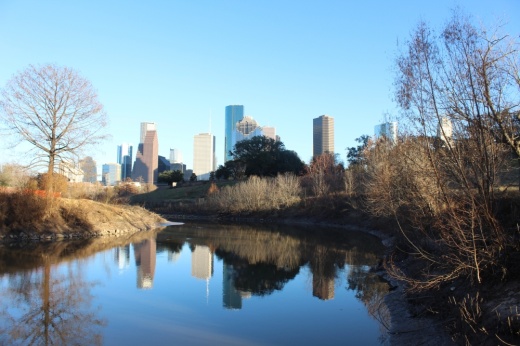The Army Corps of Engineers—the federal agency carrying out the Buffalo Bayou and Tributaries Resiliency Study—announced Feb. 14 the Harris County Flood Control District would be stepping in to take the lead on the technical analysis of certain mitigation concepts, including the tunnel.
The move comes more than two years after the Army Corps released its first interim report, one that generated negative feedback from stakeholder groups who wanted, among other requests, the tunnel to be more considered. The Corps then said it would revisit the study in December 2021 with plans to release a new interim report.
“We’re excited to continue working with the Harris County Flood Control District to find a way to bring the communities along Buffalo Bayou an effective means to further reduce flood risks,” said Col. Rhett Blackmon, the Corps’ Galveston District commander, in a statement.
Officials with some of the stakeholder groups who have been following the study—including Barker Flood Prevention, Houston Stronger and Buffalo Bayou Partnership—said the larger role for the HCFCD is a positive step.
Buffalo Bayou Partnership President Anne Olson said the flood tunnels would have less environmental disruption on the bayou than other Corps recommendations, namely channelization, or deepening and widening the bayou. In a March interview, she said the partnership was happy the HCFCD would take on a larger role moving forward, citing a strong relationship with the district.
“Virtually all of our projects have had some sort of funding from the HCFCD, so we consider them a great partner,” she said. “I think it’s a really positive development.”
Study origins
The Corps launched the Buffalo Bayou study in the wake of Hurricane Harvey in 2017 with the goal of identifying actions that would reduce flood risks to people, property and communities namely within the Buffalo Bayou, Addicks and Barker watersheds.
During Harvey, record flooding occurred at every bridge along Buffalo Bayou with water elevation levels affected by the Corps’ decision to empty the Addicks and Barker reservoirs, leading more stormwater to flow downstream, according to a post-Harvey analysis by the HCFCD. An estimated 17,090 homes along Buffalo Bayou flooded, per the analysis.
An earlier interim report from the Corps released in October 2020 was criticized by some groups along the bayou for one option that called for deepening and widening the channel.
The option—one of several favored by the Corps’ cost-benefit analysis—raised environmental concerns. Meanwhile, an underground tunnel was viewed less favorably by the Corps because of its cost, estimated to range from $6.5 billion-$12 billion.
Moving forward, the HCFCD aims to find a cost-effective, implementable and community-supported solution to reduce the flood risk associated with the Addicks and Barker reservoirs; secure federal funding for design and construction; and enhance the resilience of vulnerable communities.
Harris County Commissioners Court unanimously approved the allocation of another $2.8 million for the analysis at a Jan. 31 meeting. In comments to commissioners at that meeting, HCFCD Director Tina Petersen said the district’s portion of the work could wrap up by December 2024, while the Corps will continue working on the study through 2026.
“Though the preferred timeline is much faster than that,” Petersen said, referring the HCFCD’s analysis.
Tunneling out
The HCFCD has been conducting its own analysis of the use of underground flood tunnels in Harris County, having already come to the conclusion that 11 of the county’s 23 major watersheds would receive the greatest benefit for a systemic approach.
District officials have estimated the implementation of a broader network of eight flood tunnels in Harris County could cost $30 billion, with preliminary construction cost estimates for a typical 10-mile segment pegged at around $3 billion-$4 billion. The Corps study suggested it could cost as much as $12 billion for the Buffalo Bayou tunnel.
Following the announcement, stakeholder groups that were critical of the interim study expressed optimism about the future. Officials with Houston Stronger said the involvement of the HCFCD was a “positive development,” while Barker Flood Prevention released a statement thanking Harris County commissioners for increasing the county’s funding commitment.
Olson said she more favors nature-based flood mitigation options, such as the use of riparian buffers, which are vegetation walls designed to slow runoff and absorb excess water.
The HCFCD is working on a $9 million effort at Buffalo Bayou Park to stabilize the bayou’s banks, Olson said. The channelization of the bayou could exacerbate bank erosion, she said.
“The problem that we have is, when these lower banks are inundated sometimes, the water level remains really high for a long period of time,” Olson said. “Then, when it drops out, that’s when we get all the sediment dropping out and the erosion.”
There will be opportunities for the public to continue giving feedback as the next stage of the study progresses, said Gretchen Brown, the study’s project manager.In its 2020 interim report, the Army Corps of Engineers looked at eight possible plans for flood mitigation on Buffalo Bayou, three of which were favored by a cost-benefit analysis. Now, the Corps will revisit some of the other concepts from the report, including underground tunnels.






